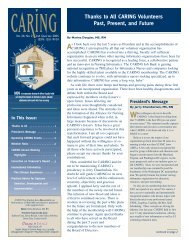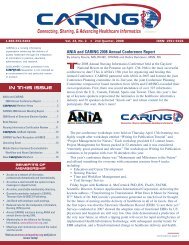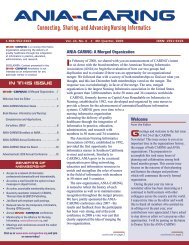Download - American Nursing Informatics Association
Download - American Nursing Informatics Association
Download - American Nursing Informatics Association
Create successful ePaper yourself
Turn your PDF publications into a flip-book with our unique Google optimized e-Paper software.
One Size Does Not Fit All:<br />
An Initiative to Improve Pediatric Patient Safety at Children’s National Medical Center<br />
continued from Page 6<br />
Printing Logic<br />
Over several months, the team worked with another vendor, Optio, to design<br />
the software logic for printing the correct size band using data entered during the<br />
registration process in admissions. Although using patient weight information<br />
might be preferred for determining band size, the majority of the patients have not<br />
been weighed prior to admission. Therefore, patient age was selected for use in<br />
printing the initial ID band. Of course, the possibility exists a band based on age<br />
will not fit the patient. Thus, the availability of printing a replacement ID band on<br />
the unit at the discretion of the nursing staff was very important to the task force<br />
charter. Three replacement ID band sizes were chosen for availability on the units:<br />
SIZE LENGTH WIDTH AGE PARAMETER<br />
Neonatal Band 6 inches 3/4 inch 0-30 days<br />
Pediatric Band 7 inches 3/4 inch >30 days < 7 years<br />
Adult Band 11 inches 3/4 inch > 7 years<br />
The concept of reprinting patient care labels and face sheets on the inpatient<br />
units from a clinical registration system is already established. With assistance<br />
from the software vendor and CNMC’s information technology services (ITS)<br />
staff, three additional files were<br />
Figure 3<br />
created in the clinical<br />
registration system to represent<br />
a neonatal, pediatric and adult<br />
ID band. When needed, the new<br />
ID band process will allow the<br />
nurse to access the clinical<br />
system on the unit, select the<br />
patient, and request a reprint file<br />
for the appropriate size ID band<br />
plan after the patient is assessed<br />
for the appropriate size.<br />
Dedicated Zebra printers for the<br />
ID bands will be located on<br />
each inpatient care unit, as<br />
shown in Figures 3 and 4.<br />
Network Preparation<br />
In order to implement the new ID<br />
band process, preparation for printer<br />
installation was required. This included<br />
use of the local area network to retrieve<br />
clinical information to formulate an ID<br />
band, but an internal technology survey<br />
revealed insufficient availability of data<br />
cables and data jacks to connect to the<br />
printers. With support from the ITS<br />
Figure 4<br />
department, the team developed a<br />
plan for the location of each printer<br />
and worked with a consulting<br />
technology company to install the<br />
data lines and drops. Each data jack<br />
was activated and tested. The jacks<br />
were clearly labeled for patient ID<br />
printer and a road map of data jack<br />
locations was provided as a resource<br />
for the ITS department. In addition to<br />
the need for additional cabling and<br />
jacks, all ID band printers required an<br />
IP address and description in order<br />
for the network to locate the correct<br />
printer. In a similar way, the printers<br />
were added to a table in the clinical<br />
registration system which identified<br />
the location of the patient care unit<br />
for point of care reprinting. The<br />
network preparation phase of the<br />
project used most of CNMC’s<br />
technology personnel resources and<br />
required more time than expected to<br />
complete.<br />
Next Steps<br />
To prepare for implementation of<br />
the new ID band process, the task<br />
force will develop and execute an<br />
educational plan for <strong>Nursing</strong> and<br />
support staff to use the new software<br />
and printers, begin actual use of the<br />
new patient ID band process, and<br />
evaluate its success. A follow up<br />
discussion of these next steps and<br />
lessons learned is planned for a future<br />
issue of the CARING newsletter.<br />
Reference:<br />
Technology in patient safety: Using identification bands to<br />
reduce patient identification errors. (2005, April). Joint<br />
Commission Perspectives on Patient Safety, 5(4), 1-10.<br />
Additional Reading:<br />
Use of Color-Coded Patient Wristbands Creates Unnecessary<br />
Risk. (2005, December). Patient Safety Authority, Vol 2,<br />
Supplement 2. Retrieved February 15, 2007, from<br />
http://www.psa.state.pa.us/psa/lib/psa/advisories/v2_s2_sup<br />
__advisory_dec_14_2005.pdf<br />
Page 7 • 4th Quarter 2006







